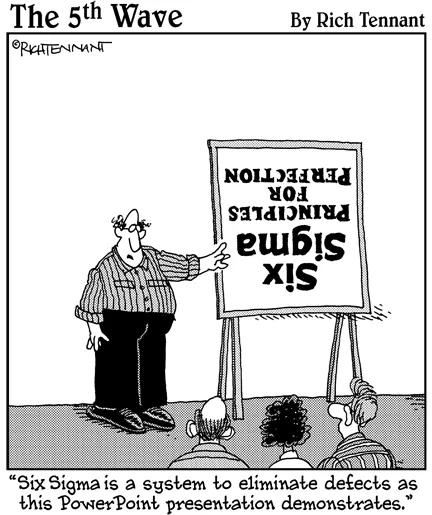Part I
Getting Acquainted with Six Sigma Basics
In this part . . .
Six Sigma is an applied methodology for improving business and organizational performance. But before you apply the Six Sigma methodology, you can benefit from knowing what it is, where it came from, why it works, and who uses it. This part provides all this information so you can understand the basics of Six Sigma.
Chapter 1
Better Business and Better Performance: Defining Six Sigma
In This Chapter
Looking at the many definitions and synonyms of Six Sigma
Introducing the proven managerial horsepower of Six Sigma
Recognizing that Six Sigma isn’t just another initiative-du-jour
Identifying a formidable business force
It’s not often that a For Dummies book topic first needs a formal definition. After all, you know in general what gardening, dating, and even marathon training are. But “Six Sigma”? Even if you remember that sigma is the 18th letter of the Greek alphabet, why six of them? And what happened to the first five sigma?
In this chapter, we offer you a foundational knowledge of Six Sigma so that the rest of this book makes sense and you can get the most out of the rest of the book, which ultimately helps your business improve by leaps and bounds.
Discovering What’s Behind the Name
It’s okay if you don’t know what Six Sigma is at all, or don’t understand every aspect of it. That’s because Six Sigma — once a precise, narrowly-defined term — has grown over time to represent a number of concepts:
Six Sigma is a problem-solving methodology. In fact, it’s the most effective problem-solving methodology available for improving business and organizational performance.
Six Sigma performance is the statistical term for a process that produces fewer than 3.4 defects (or errors) per million opportunities for defects.
A
Six Sigma improvement is when the key outcomes of a business or work process are improved dramatically, often by 70 percent or more.
A
Six Sigma deployment is the prescriptive rollout of the Six Sigma methodology across an organization, with assigned practices, roles, and procedures according to generally accepted standards.
The
Six Sigma toolset is the collection of methods and tools, including statistics and analytics, that Six Sigma practitioners use to consistently achieve breakthrough levels of improvement.
The
Six Sigma methodology is often combined in practice with Lean methods in a hybrid practice known as
Lean Six Sigma or
Lean Sigma.Six Sigma is a methodology for minimizing mistakes and maximizing value. Every mistake an organization or person makes ultimately has a cost — a lost customer, the need to do a certain task over again, a part that has to be replaced, time or material wasted, efficiency lost, or productivity squandered. In fact, waste and mistakes cost many organizations as much as 25 to 40 percent of their revenue! That’s a shocking number. Imagine throwing 25 to 40 percent of your money away in the garbage every time you cash a check. It may sound ludicrous, but that’s what many organizations do.
All businesses, organizations, and individuals have room to improve. No operation is run so tightly that another ounce of inefficiency and waste can’t be squeezed out. By their nature, organizations tend to become messy as they grow. Processes, technology, systems, and procedures — the ways of doing business — become cluttered with bottlenecks, meaning work piles up in one part of the organization while other parts sit idle with nothing to do.
Work is often performed incorrectly, or the outcome is flawed in some way. When this situation happens, you scrap products and services and have to do the work over again. You consume additional resources to correct a problem before it’s delivered to the customer, or the customer asks later for a “redo” — a new product or a more satisfactory service.
Sometimes, flaws and defects aren’t the problem, but a product or service simply takes too long to produce and deliver. Think about the problems a mortgage company would have if it processed home loans perfectly but did so five times more slowly than the competition. That’s a perfect disaster.
Six Sigma was once a quality-improvement methodology, but now it’s a general-purpose approach to minimizing mistakes and maximizing value: How many products can you produce, how many services can you deliver, or how many transactions can you complete to an expected level of quality in the shortest possible amount of time at the lowest possible cost?
Six Sigma takes effort and discipline and requires you to go through the discomfort of change. But soon the pain is transformed into improved performance, lower costs, more success, and happier customers.
Tackling Six Sigma from the Managerial Perspective
Although Six Sigma has many definitions (see the preceding section), Six Sigma action occurs on two levels: the managerial and the technical. This chapter introduces the managerial level, while Chapter 2 begins to look at the technical side.
At the managerial level, a Six Sigma initiative includes many units, people, technologies, projects, schedules, and details to be managed and coordinated. It also involves developing many plans, taking many actions, and completing a lot of specialized work. For all these factors to work in concert, and for the technical elements of Six Sigma to be effective, you have to set the proper management orientation.
Bridging science and leadership
From a management standpoint, you use Six S...













